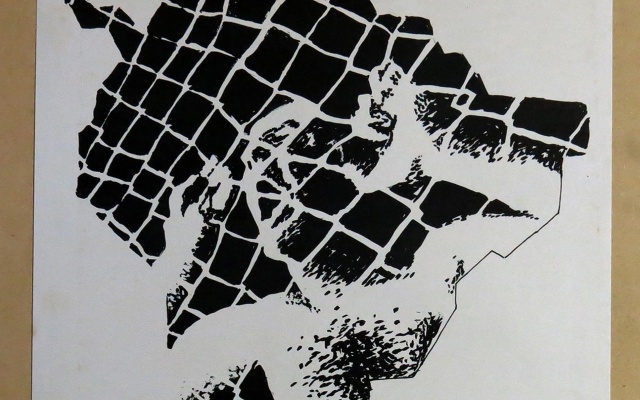This is expanded version of the text which was presented in the seminar Archivos del Común 2 “El archivo anómico” (An Archive of Anomie), held on 29 September 2017, in Madrid's Museo Nacional Centro de Arte Reina Sofía.
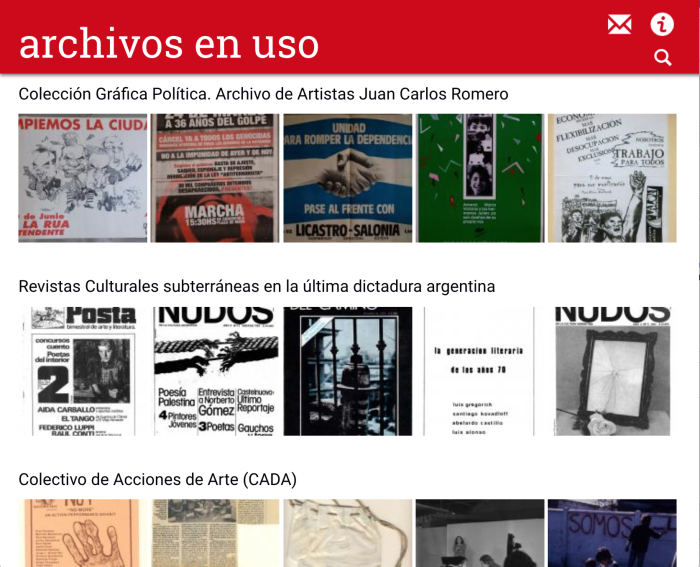
Zrzut ekranu strony Archivos en uso: http://archivosenuso.org/
How should we think about our practices as researchers, archivists, and theoreticians in co-existence and in “phase” with our environment? How to position oneself from an ecosophic perspective of the common as a way of being in the world? What forms of organization, activation, and even common production are possible from this perspective? Both natural and social resources – human and non-human – cannot be thought of in a fragmented or divided up manner. As Silvia Rivera Cusicanqui puts it, “... the social sciences – along with several others – should focus on creating the conceptual, technical, and material tools to resist the pillaging, both of material resources and of people (labor of hands, brains) or, at least, help us to survive to it.”
The work of the Red Conceptualismos del Sur [Southern Conceptualisms Network] (RedCSur) is inscribed in a perspective that strives to disarticulate notions of property and colonialism that weigh as much on earth and the cosmos as on knowledge and forms of action. In this sense, in its Founding Declaration, the Southern Conceptualisms Network adopts “a strategic use of the term ‘South.’” It is used with the purpose of intervening into the geopolitical segmentation of Latin America, within the current hemispheric conjuncture. The geopolitical condition of the “South” is not used as a metonym for the geography of Latin America, but as a discursive tool for dismantling “centrality” and reversing the epistemic “marginality” through which global “conceptualisms” have been historicized. Through the strategic and geopolitical use of the term “South,” the Network seeks to ensure that the Latin-American stance is informed not by a reclamation of some regional cultural identity, but rather, that it allows the rethinking and revision of the strict dichotomies that divide center and periphery, canon and counter-canon, first and third worlds, western and non-western. Rejecting the capitalist ideologies of appropriation, the RedCSur, is established as an affective-political community endowing itself with forms of self-organization where the historical division between theory and practice is inoperative, ineffective.
Begun in 2007, the Red Conceptualismos del Sur is a platform which today brings together around 50 scholars and artists from Latin America, Europe and Canada. The Network defines itself as a platform for research, debate and collective position-taking from Latin America. The platform is currently organized into four core areas or “nodes”: research, publications, web and archives, each of which has at least one delegate and regularly holds virtual meetings. Each node connects work teams around the various projects the network is conducting. A coordinating team is made up of the delegates of each node plus two coordinators.
The Red Conceptualismos del Sur has arisen at a moment in which the documents and archives of Latin America’s artists and collectives have begun to turn up on the radars of major museum and academic institutions, especially in the United States and Europe. It is in this framework that the RedCSur emerges with a positioning that does not point to one single front, but which, on the contrary, refracts into a number of focuses. On the one hand, it was motivated by the wish to construct a space for collective work and reflection that might adopt a geopolitical stance from the south (conceived not as a geographical but rather as a strategic point) and that, on the other hand, could intervene in what has turned into the current, generally accepted forms of plunder, concerning, among other things, art archives.
Historically, archives have been thought of in their mnemonic dimension, i.e. the possibilities of their being guardians of memory. Without in any way ignoring this dimension, the RedCSur envisions a contemporary relationship with archives which aims to think about them from the possibility of their producing and generating familiarity and affection vis-à-vis the present, since it is in the present that we find the only framework in which the past takes on meanings, or makes sense. As part of its working policies, the Red Conceptualismos del Sur makes available not only the reflections that have arisen from the research it conducts but also the raw materials that construct and enable that research, opposing, and responding to policies of withholding and privatization of knowledge and of academic production. Establishing archives and opening up access to them is in itself a form of producing narratives, and at the same time, it is a strategy we do not carry out without evident tensions, above all in a setting that increasingly valorizes archives in the art market and in the dizzying processes of disabling multiple meanings and homogenizing them under the guise of plurality. Accordingly, we recognize that the RedCSur is not some agent external to the valorizing process of the archives with which it works. It is our very research work which has managed to inventory, organize and build documentary collections which, in many instances, were previously in disuse, abandonment, ruin or neglect, and which lack conditions for their maintenance, protection, and access. The members of the RedCSur, being investigators, went from being passive appropriators of documents and information to actively redistributing information and presenting situated views of their material, directly contributing to producing communal bases which not only socialize images, texts, and videos, but also expand their modi operandi. This implies constantly going back to the time gaps and the convergences between desires and practices. And it also implies knowing that, although desires don’t always translate into practices, they may provide us with images that broaden the horizon of the possible and open up perspectives in a labor we know is to be long-term. Amid the tensions and negotiating of interests generated between the agents who take part in the establishing of archives – artists, researchers, and curators, as well as the museum directors or collectors interested in acquiring archives – the network seeks to dispute meanings and intervene in the practices of archives.
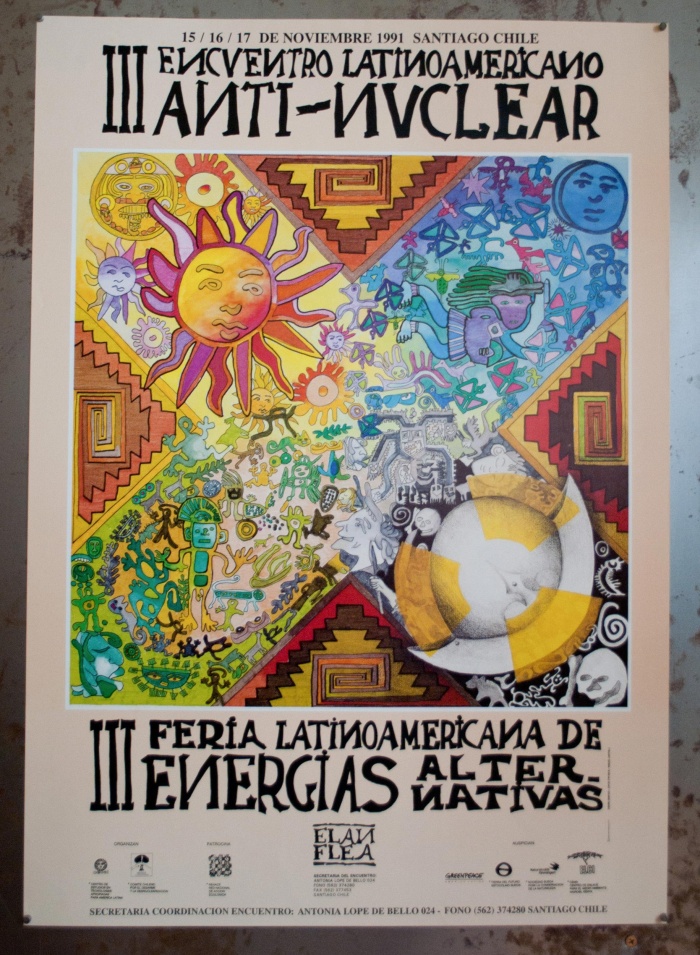
III Latynoamerykański Zjazd Przecijądrowy, 1991, Centro de Estudios en Técnologías apropiadas para América Latina y Comité Chileno por el desarme y la desnuclearización [Chile]. Archiwum Juana Carlosa Romero. Papier, 76x53,5 cm. Via: http://archivosenuso.org/

Nuestra señora de la Rebeldía, 2007. Ikonoklazm, Argentyna. Papier, 58x81cm. Archiwum Juana Carlosa Romero, via: http://archivosenuso.org/
Having, in practice, tried out various ways to organize, manage and socialize archives, the RedCSur has come to set out a policy for archives posited to “contribute to the indivisibility, preservation and public accessibility of archives of Latin American art, promoting their presence in the places in which their practices were produced.” This network policy is far from being something to be taken for granted and is constructed within an often conflictual force field. This ethical commitment does not a priori reside in the way in which the artists conceive of the relation with this archive, and in this sense, it is a policy the network tries to inoculate. The network organizes its action with the intent that its program be desired, appropriated, constructed through the collaboration of its members, in alliances with other agents.
In this way, we aim to work from the singularities of each archive, from their potentials and differences but also from their deficiencies, assuming, in each moment, the place of enunciation from which work is carried out, a place of enunciation which is at once personal and collective. It is thus that we permanently confront the requirements of standard systematizations, the demands of neutrality, in the long protocol of archival norms; structures which compose and determine the discipline of the archival, which we also continually refuse for ourselves. Without in any way denying the value of those structures, the work of our network takes on other formats, follows other paths. Perhaps, most clearly, from the research and exhibition project Perder la forma humana (Losing Human Form), it was possible to formulate, as a work methodology, the figures of affinities and contagions which are ways of thinking and doing, which attempt to oppose the professional, “departmental” fragmentation and, in contrast, undertake network labor as a stratum with various folds to it. Research, and the collaborative forms of writing, operate through affinities and contagions, as do the institutional alliances which the RedCSur establishes in its directive policies. At the same time, as happens with all work with archives, there hovers over us the treacherous specter of wanting to encompass everything, of imagining a possible totality, of adding more and more, of not leaving out this or that, a sort of incessant search for the archive's holy grail. There is the clear risk that, as can happen with the paradigm of the internet, the excess of documents ends up transforming itself into a kind of “memory of dis-remembering,” of non-memory, whereby the overaccumulation of information ends up repressing historical memory, and our bodies end up lying under those heaps. It is a matter, therefore, of working out both one’s own methodologies as tools and the frameworks from which, with both mistakes and accurate assessments, to work toward the construction of an inappropriable archive.
This inappropriability may be thought of in three related senses; on the one hand, the inappropriable may be part of a trait inherent in every archive, related to the impossibility of totality we have just mentioned. On the other hand, the inappropriable resides in the construction of possible senses, or rather, in those senses that elude us, that we cannot grasp, that slip away before we can name them. In this aspect, the inappropriable is manifested out of the interstices of the archive, from its faults, its gaps. Lastly, we also think of the inappropiable as the disarticulating of the logics of property which characterize the establishment of archives. In this sense, an inappropriable archive alters, from within, the center placed in the owner or in the property itself in order to promote its use value.
So, even if it is only recently that the RedCSur has attained its status as a legal entity, it is not an institution, as a university or a museum would be. The RedCSur does not try to garner a legacy of its own as an institution; it is not related to the archives, from the logic of property, but rather, it tries to promote collaborative forms of use and organization of the art archives from the bottom up, in a context of the institutional and political precariousness of archives in Latin America. We also know, of course, that there are other forms of accumulation that have to do with reputational and symbolic heritage to which we are no strangers; the value we contribute to generating in the archives, no doubt also falls back on the symbolic patrimony of the RedCSur, which at the same time we try to neutralize through various strategies.
La RedCSur works from a perspective of archive use and in particular from an instituting use of those archives, conceived as shared or communal. When we say communal, we are thinking anew of putting into crisis, through the practice or “use,” the logic of property. It is the tension between property, understood as an exclusive and nominal decision, and the communal, more than the tension between the public and the private, that motivates our modi operandi. As it is our starting premise that every archive, in addition to modulating singularly its configuration and rules, takes refuge in structures of various juridical-programmatic character, so that we posit that the public/private dichotomy is insufficient for understanding what occurs in each case. The network itself develops a policy of alliances in which, both in the personal archive open to the users in the house of the artist who has harbored it, and in that of an archive which functions in an autonomous, space independently operated by a group, or even when the archive is ceded to a museum or a university, there are multiple agents (institutional and extra-institutional) who work with their institutionalization. In all cases, entities are produced which break with the logic of exclusivity (it is our insistence, in our work, that archives be neither withheld nor closed). Neither is the personal archive entirely private, nor have those which are institutionalized entailed a total subsuming of the archive to the logic of the museum or the university: not only do the institutions act upon the archives, but our practices and methodologies for working with the archives also act upon the institutions, transforming them, no matter how minimally, in accepting other criteria, other ways to catalog, to organize, and other policies of access to the documents – even from starting to imagine them as possible. If, then, it is the tension between the logic of the communal and that of property, which animates our practices, it must be said that the possibility of communal use of archives which the net mobilizes, does not, in any totalizing and continuous way, operate on the archives with which we work (property, capital, also carry on their work there). On the contrary, the possibility of communal use of the archives is a process marked by small triumphs as well as by contradictions, flaws, and blind spots.
In this text, we seek to think about the possibility of archives without property, promoting its use value, and in this sense, we ask ourselves how we should think about the use of the inappropriable. The RedCSur seeks to think about the archives as the production of a commons, and the user of something common and communal is not an owner, a proprietor. The notion of use may name quite different things. The proprietor or beneficial owner of some good may, to be sure, use it. In contrast, as Pierre Dardot and Christian Laval point out, “the use of a communal asset does not proceed from some broadened or shared property,” but rather from “the co-obligation that prevails between those who at once have use of what lies outside of property.” At this point it may be important to point out: the researchers on the web not only “extract” knowledge of the archives, but rather their use of the archives implies a commitment, as well as a co-responsibility with the ways to imagine, gain access to, and organize that archive.
We are, at present, in a context in which the very category of property is going through a change, and has been expanded, extending toward new forms, such as use and access, which are having a decisive importance in the transformations of contemporary capitalism. In this sense, the Internet offers an enormous field for the extension of the economy of communications, in which the most important thing is no longer the sale of goods, but rather commercialization of uses of goods and access to services. This model speeds up the logic of capital accumulation (in the “educational, cultural, cognitive, and relational sphere”), boosting the formation of large oligopolies which concentrate the property of the media of access and satisfaction of needs (the consumption media). As a path for the socialization of archives but also as an intrinsic methodology of the RedCSur, one fundamental tool has been the Internet, which, as we know, today constitutes a dispositif for circulating information and, at the same time, a speed-up vehicle for capitalism and for the control of the population, which breeds forms of subject-making and subjection [subjetivación]. As already occurs with many platforms for group labor, the Internet is, and has been, an enabling condition for the RedCSur and at the same time, one of its fields for intervention. We aim to have our practices take on and problematize the fact that, even if technologies are pitched as neutral, they leave in the shadows the material and economic structures that make them possible. The immateriality of the Internet subsists thanks to the materiality of submarine cables and the ever-so minimalist constructions that contain the servers, as well as by dint of the economies of extraction (for example, the case of lithium). On the other hand, as the Argentine sociologist Christian Ferrer has suggested, in order to function as such, the Internet needs to legitimize information production as a form of knowledge, which seems to prompt our return to the paradigm of positivism, whereby the decontextualized datum takes precedence over the construction of knowledge. And this purported access to unlimited information, which grows increasingly boundless, leaves the subject in a state of permanent debt, since it is impossible to access all information.
Since 2009, our work with archives has allowed us to observe that the purchase of archives (or a part of them) by collectors or museums does not necessarily stand in opposition to the openness and accessibility of those collections on the web, in a context in which the very category of property has changed and broadened, so that today, property rights have been diversified and include rights of access, use and control, in the same category as property rights. Thus, on many occasions, the commercialization of archives falls within a logic of (alleged) “free circulation,” which enhances their value.
The “archives in use” platform (archivos en uso: http://www.archivosenuso.org) is the critical dispositif with which the RedCSur is experimenting with ways to socialize documents. It is a platform which is not associated with any available institutional web site, being available (for now) only in Spanish, which gives it less visibility within the Internet’s geopolitical distribution. Archivos en uso has allowed us to think how to create conditions for working out protocols and commitments in joint use of the art documents with which we work, outside the logical of charging for rights of accessibility (as do various other portals for art archives). In turn, this virtual platform has led us to think about how to counteract the incorporation of archives into an economy of signs which enlists them as a mere exchange value, and thereby yields operations of homogenization, producing equivalent values for different “products.”
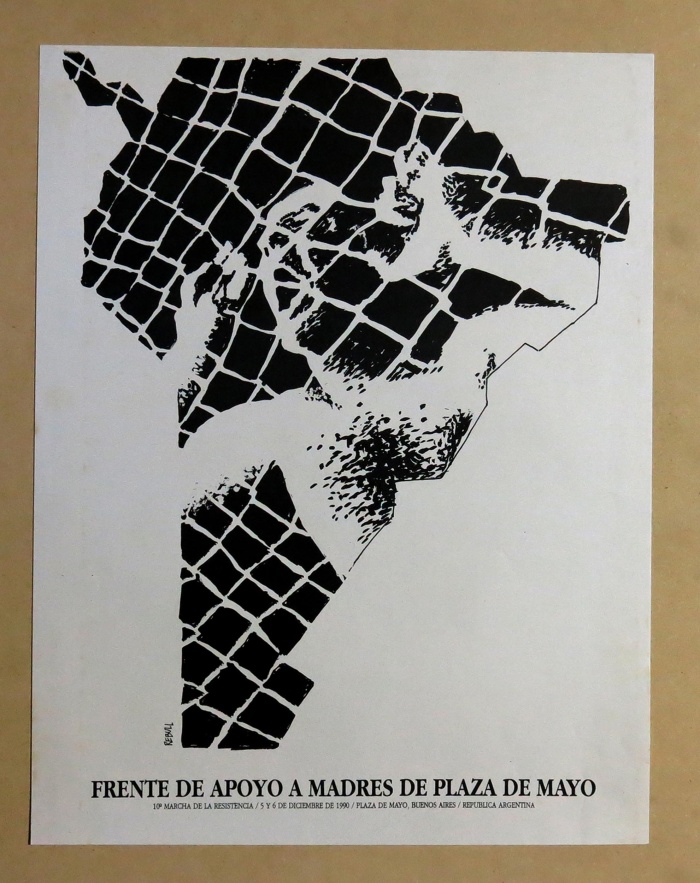
Ruch Oporu 10 Marca, front wsparcia ruchu Madres de Plaza de Mayo (Aregentyna). Papier, 44x34 cm. Archiwum Juana Carlosa Romero. Via: http://archivosenuso.org/

Ajuste = 2000, Filomia, Argentyna. Papier: 110,5x71 cm. Archiwum Juana Carlosa Romero. Via: http://archivosenuso.org/
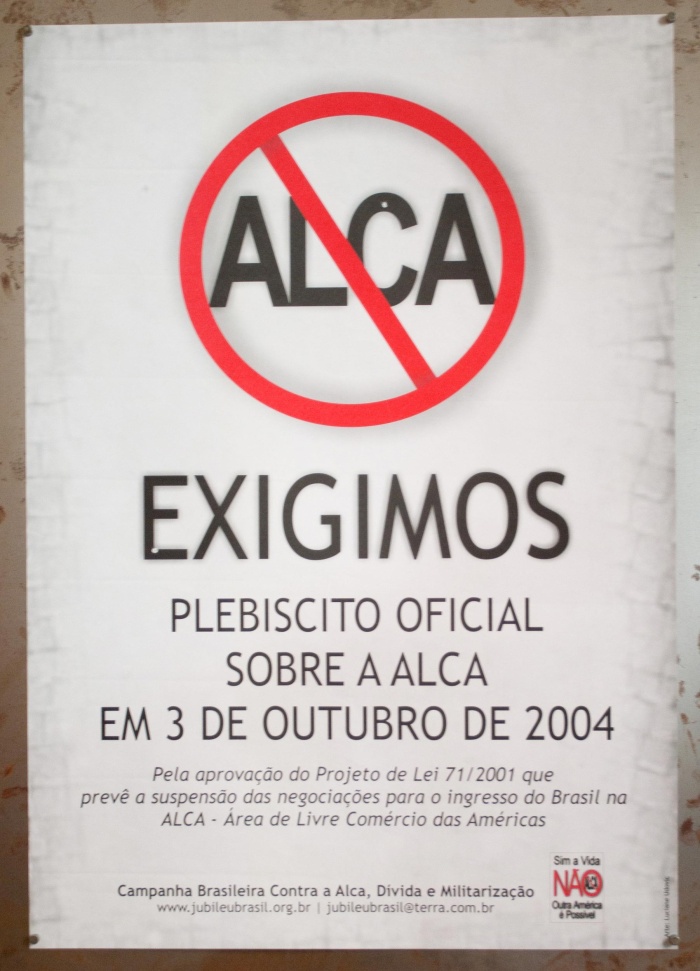
Żądamy oficjalnego referendum w sprawie FTAA (ALCA), Campanha Brasilera Contra Alca, 2004 (Brazylia). Papier, 60x42 cm. Archiwa Juana Carlosa Romero. Via: http://archivosenuso.org/
When the RedCSur began its work, one of its major concerns was to “unframe” or broaden the ways for historicizing the art archives with which we work, in order not to inscribe them in linear, modernizing, and universalist narratives that might tend to place them in some out-of-phase or delayed position in relation to Northern-hemisphere experience. Ten years after the birth of the RedCSur, the geopolitical map has been altered. Today the North as it figures strikes us as less stable, in a setting in which not only the concentration of power has shifted, and the State are no longer the main player in the political game, but rather transnational-global capital. In the context of the expansion of globalization, the widening of artistic canons has sped up, not without the effects of leveling, homogenizing and decontextualizing. It may be that today the problem is not so much being placed in a time-gap but rather the way in which the temporal acceleration flattens the textures and agitations of different spatialities. The dispute, then, is over trying out lateral narratives and bodies of knowledge from the archives, which produce opacity with regard to the Internet’s universalizing transparency and which, at the same time, show a pulsation of the thick contextual conflictiveness of the documents. What we propose is to carry out a materialist work of friction, a rubbing with and between documents, which can allow us another form of contact with historical contingency, with what was has been, and still is, unforeseen.
To come back to an intensive notion of use, we know that access on the web is not enough. Today, more than ever, archives have incorporated the value of change, and the Internet is a platform that intensifies their value. That said, incorporation of the value of change in archives does not bar their use value, which is, after all, a value free of wear and tear, free of loss, in which, however, some transformation is always taking place. A transformation which allows us, to come closer, however slightly, to grasping the inappropriable.
Translated from the Spanish by David Jacobson
BIO
The Red Conceptualismos del Sur [Southern Conceptualism Network] (RedCSur) is a collective initiative bringing together around 50 researchers and artists from various regions of Latin America, Canada and Europe, establishing itself as a platform for collective thought and action in the field of contemporary relations between art and politics. It was founded in 2007 by a group of researchers concerned with intervening politically in the processes of neutralising the critical potential of conceptual practices developed in Latin America since the early 1960s. The RedCSur has been involved in long-term reflection on the uses and politics of archives, working on the establishment and organisation of some of the most significant artist-held archives in South America. The platform archivosenuso.org is an open-ended tool to share its archival investigations. Among other research projects, the network led the exhibition and the publication of Losing the Human Form. A Seismic Image of the 1980s in Latin America, produced in collaboration with the Reina Sofia Museum. Recent publications include Desinventario. Esquirlas de « Tucumán Arde » en el archivo de Graciela Carnevale (Santiago de Chile, 2015) and Arte y disenso : memorias del Taller 4 Rojo, (Bogotá, 2015).
Fernanda Carvajal is a sociologist, teacher, and researcher at Buenos Aires University. Holder of an MA degree in Communication and Culture and a PhD degree in Social Sciences. Since 2008, she has resided in Buenos Aires and worked at the crossroads of art, politics, and sexuality since the 1970s in Chile. She is involved in the group “Art, culture and politics in Argentina” directed by Ana Longoni and the group “Micropolitics of sexual disobedience in contemporary Argentine art” directed by Fernando Davis. Alongside Mabel Tapia, she co-coordinates the group Red Conceptualismos del Sur, within which she formed the curatorial team of the exhibition Losing the Human Form. A Seismic Image of the 1980s in Latin America at Reina Sofia Museum in Madrid in 2012 (also shown in Lima, 2013 and in Buenos Aires, 2014). At present, among other projects, she works together with Alejandro de la Fuente on the establishment of the Mares of the Apocalypse Archive.
Mabel Tapia is a researcher from Buenos Aires, living in Paris. Her research focuses on art practices in the 21st century that involve the use of archives, activism, political engagement and deactivate the aesthetic function. She also investigates the processes of legitimation, valorisation and visibility of contemporary practices in their relation to the phenomenon of reification in the frame of new paradigms in both artistic and socio-economic fields. She is currently co-directing with Stephen Wright the PhD programme “Document & Contemporary Art” organized by the art schools EESI and ENSA, Bourges. Alongside Fernanda Carvajal, she co-coordinates the group Red Conceptualismos del Sur. She also works as an editor and has recently co-ordinated the edition of the catalogues: Losing the Human Form. A Seismic Image of the 1980s in Latin America (Madrid: Museo Reina Sofía, 2013; Buenos Aires: Eduntref, 2014) and Really Useful Knowledge (Madrid: Museo Reina Sofía, 2014), Desinventario (Santiago de Chile: Ocholibros, 2015).
*Cover photo: March 10 resistant movement, 1990. Paper, 44x34cm. Archives of Juan Carlos Romero



